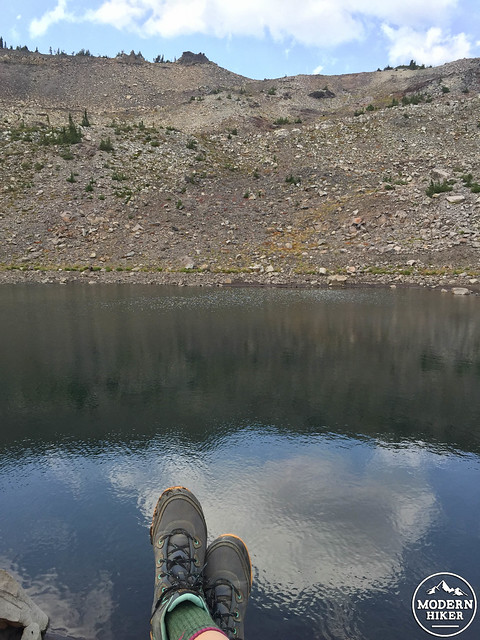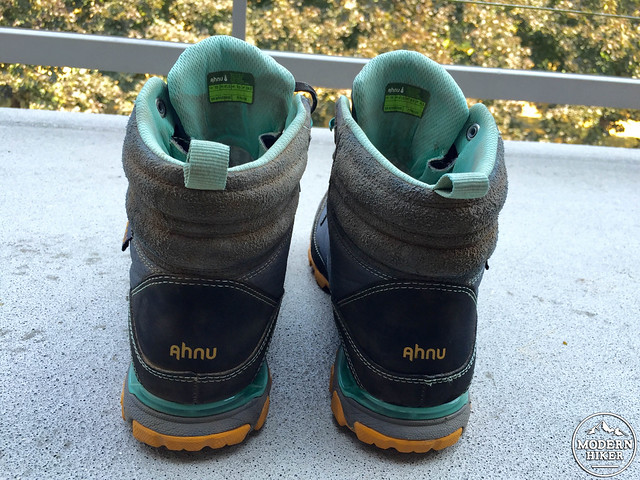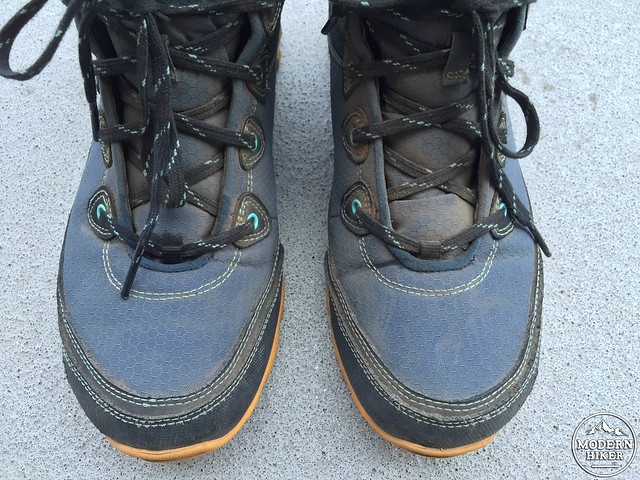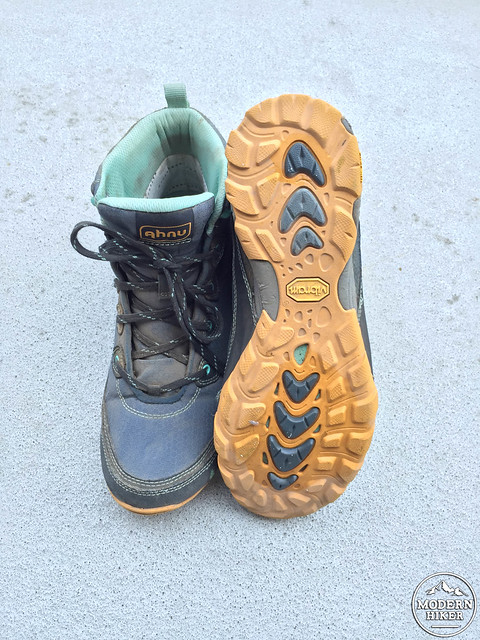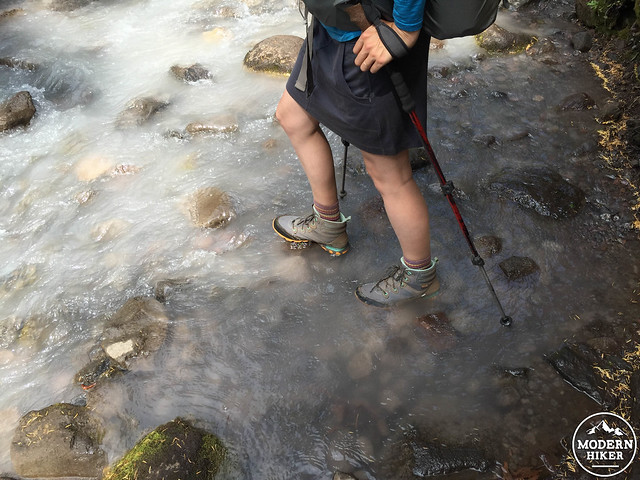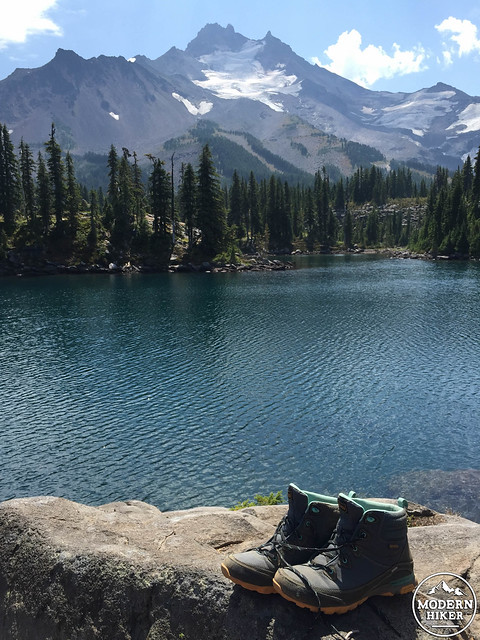Rating: 5 out of 5 stars
I will admit something. When Ahnu first introduced their women’s Sugarpine boot, I was immediately intrigued. It was so stylish, so colorful, so waterproof. Unfortunately, I was also deep in my “trail-runners for everything” phase, where I had sworn off full-height boots for the promise of breathable, lightweight, fast-drying shoes (which, coincidently involved me feeling pretty cool and hardcore while telling others about how they “didn’t need real hiking boots”).
In fact, my initial thought was: “I really like the colors, but I can’t get them, because THAT would be so girly, and I’m not very girly.”
Fast forward to 2015, when my views on shoes have become more refined, and more situational. Sure, sometimes I still use trail-runners for backpacking and day-hiking, but I’ve also started to use my full-height and supportive boots just as often. Specifically, I use boots for three main types of adventures:
-When I know I’ll be doing significant off-trail travel
-When I know that the bottoms of my feet will hurt earlier in the day with trail-runners, especially on very loose, rocky trails or rock scrambles
-When I know I’ll be doing some snow travel that is more than just a few random patches here and there
Keeping this in mind, the timing could not be more perfect for me to give the Sugarpine boots a try. A major selling point of these boots (and in fact their entire Sugarpine line of shoes) are the colors. Want something flashy (and dare I say, girly?), they’ve got you covered. Want something more traditional looking? Perhaps with some earthy tones? There’s something for you too. For my color, I decided to go with Dark Slate, a lovely mix of a yellow Vibram sole with what I describe as a blue/green earthy color. According to Ahnu’s product specifications, the boots also feature:
- Ahnu’s waterproof, breathable technology
- Vibram® non-marking outsole and slip-resistant lugs provide grip and traction on varied surfaces
- Numentum™ Hike technology with a lateral to medial TPU heel clip for neutral positioning and stability
- Waterproof mesh, leather and suede upper
- Gusseted tongue helps keep debris and dirt out
- Moisture wicking mesh lining
- Rubber toe protector
- Dual-density EVA, removable footbed provides extra shock absorption with heel and arch support
- Integrated nylon shank and arch support provide torsional rigidity and mid foot support
- Shock dispersal plate in forefoot for stone bruising protection
- Self-cleaning lugs
- Weight: 11.6 oz.
All this to say: the boots are supposed to be breathable, waterproof, sturdy yet lightweight, and offer neutral positioning for the foot. To test out these claims, I recently took my shiny new boots on a 3 day backpacking trip to the lovely Willamette National Forest here in Oregon, where I planned to travel both on and off-trail in the gorgeous Jefferson Park area. While I usually take the time to change out the insoles of all new boots, the Sugarpine is meant to be a “ready to go out of the box” boot, so without having worn them once, and with the factory insoles, I took off on my first day to climb roughly 2,000 feet over 6 miles. For the next 2 days, I would day-hike, rock scramble off-trail, and walk through streams to put these boots to the test.
Conclusion? I was pleasantly surprised.
Comfort: As claimed, these boots are very comfortable right out of the box. As someone who enjoys hiking in light-weight trail runners, the Sugarpine is the perfect in-between option. You get the very light, comfortable feel of a trail runner, while also having some of the sturdy aspects of a full-height hiking boot. At no point during the trip did I get that “oh no, I’m wearing new hiking boots and this hurts” moment. As mentioned earlier, a big selling point for me, and a major reason why I would generally pick boots over trail-runners for certain trips, is the potential for pain on the bottoms of my feet during on and off-trail travel. True to being a boot, the bottoms of my feet were indeed less sore. The build of these boots offer a great in-between: sturdy comfort that still offers a good amount of flexibility for rock scrambles. While I wouldn’t consider it a wide boot, it certainly gave my normal width feet room to spread out comfortably.
Grip and Stability: I REALLY enjoy finding an off-trail location on a map and navigating my way to that place, thus ANY boot has to put up with possible unstable rock scrambles, steep inclines, and unexpected terrain. Overall, I was pleasantly surprised at how well the Sugarpine boots did during an off-trail scramble from the beautiful Pacific Crest Trail to a mini glacier at the far side of a valley. The Vibram soles provided a great “sticky” feeling when walking through a field of loose boulders, and overall, I could have done miles more by the end of the day. Similarly, I felt that on-trail travel was comfortable and supportive, especially for brand new shoes. One thing to note: I DID get one small blister on the bottom side of my right and left middle toes. However, blisters are caused by a multitude of different interacting factors, and I probably can’t entirely blame the shoes.
Waterproof and breathability: One main complaint I have with the Sugarpine boot is that it doesn’t feel as breathable as they claim. As someone used to wearing light, airy trail runners, there were times when my feet felt really warm, especially at mid-day when the temperatures were a little higher. My suggestion is to experiment with socks (I happened to have been wearing some Darn Tough merino socks, since I wanted to test them out). However, on the plus side: When my fellow (trail-runner wearing) trip mates were cleaning off very dirty feet at the end of the day, mine were looking great. Finally, I deliberately (and needlessly) walked through a glacial stream to test the waterproof claims of the boot. I found that the surface repelled water perfectly, and that my feet stayed dry even after standing in the water up to my laces for several minutes. Using a full-bootie membrane that encloses almost the entire boot, water can reach almost the top and still be kept out. While I can’t speak to the long-term life of the waterproofing, it worked great out of the box.
Durability: One big question, which remains to be seen, is one of durability. While the lightweight, flexible nature of the boot lends well to its role as a possible trail-runner/boot hybrid, it feels noticeably less solid than a traditional boot. However, only time will tell, and after 3 days of use they still look great, if not a bit dirty (which means they were used).
Overall, the Sugarpine full-height boot is a great option for anyone looking for the support of a boot with the weight of a trail-runner. This is especially true for those interested in exploring off-trail while also wanting a lighter boot that affords a less clunky on-trail feel.
Also, did I mention the colors?
Winter 2016 update: I still CONSTANTLY use these same boots for winter hiking, and they’ve been through countless streams and mud pits. They’re still holding up great!
Tags: Ahnu, Backpacking, gear review, Hiking, hiking boots, waterproof

